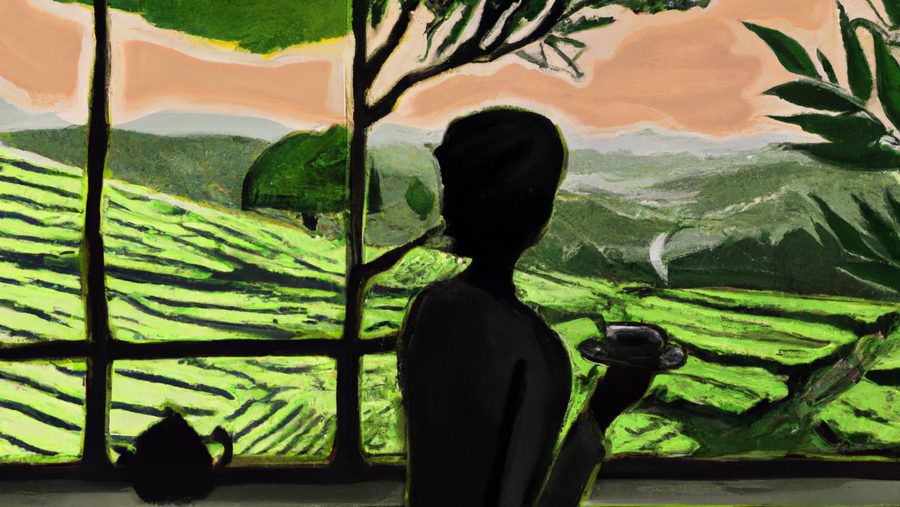Green Tea: A Beginner's Guide!
If you're curious about green tea but don't know where to start, this article takes you from the buying process to making the perfect brew.

Imagine sitting outside enjoying a beautiful, brisk morning. You are lost in contemplation imagining the inner lives of all the little creatures scurrying around before you. And then a distinct and pleasant aroma snaps your attention back to the steaming cup of tea you’ve just made yourself. You lift the mug, close your eyes, and take a sip. The warmth of the tea makes you smile. The flavors intrigue you as they evolve and linger.
This experience is accessible, whether you're an experienced tea drinker or brand new! It's just a matter of choosing teas that you enjoy.
What is Green Tea?
Green tea comes from the Camellia Sinensis plant, the same plant that the other four types of tea (black tea, oolong, pu-erh, and white tea) come from. Green tea is different from black tea because is what happens after the leaves are harvested. This process gives the green tea leaves a bright, grassy, and sweet flavor profile.
How to Taste Green Tea
There is a wide variety of experiences you can have while drinking green tea because it comes in so many different styles! Japanese green tea often yields a bright and sweet flavor profile that some may describe as “grassy”, because there are many styles where leaves are steamed after harvest. Chinese green tea, however, has a tendency to be slightly "toastier", with a deeper, roasted flavor profile. This is due to the leaves being pan-fired after harvest.
When trying to describe the flavors a green tea can have, it's important to know a few key terms.
Vegetal is a word that is most commonly used to describe green tea– because it refers to a green or grassy flavor profile. The leafy-green flavor is reminiscent of edamame.
Umami is defined by a brothy mouthfeel and savory flavor. It directly translates to "essence of deliciousness". It’s commonly found in Japanese green tea. It's recognized as the core fifth taste. It was discovered in Japan in 1908, but wasn't universally recongized until a 2002 study. The study found that there are taste receptors which allow humans to recognize umami flavors when protein is present in a food.
Floral is mostly used to describe aroma. There are different types of flowers that are used to describe flavors and aromas, like "orchid". It’s important to note: just because a tea is described as floral doesn’t necessarily mean it’s a tea blend with flowers in it, but that those are the flavors that are in the brew.
Brine-y flavors leave an impression of fresh sea air, often found in Japanese green teas.
Mineral-y flavors are clean and crisp, reminiscent of rain on a cozy day.
Bitterness is used to describe the sharp flavor that might come through at the back of the tongue if a green tea is overbrewed, while astringency is the physical sensation that lies in the middle of the tongue, and is associated with a dry mouthfeel and sourness. Importantly, bitterness and astringency aren't necessarily bad. There are many layers to a tea, and these components in moderation can add a wonderful depth of flavor. They only become an issue when they overwhelm the rest of the flavor.
It might feel easy to mindlessly drink sip after sip until you reach the bottom of the cup and realize that you didn’t take the time to taste the nuances of the tea. To avoid this, it might be helpful to close your eyes and note the flavors that you’re experiencing. Ponder the adjectives listed above, which would you use to describe the depth of your cup? Do any additional terms come to mind? Feel free to comment below!
Drinking tea can be an incredibly meditative experience– taking a sip, noticing the flavors, and ensuring that you’re not swallowing it too fast to fully enjoy the cup.
The Art of Choosing Your Green Tea
There is a wide variety of green teas to choose from! If you’re looking for one with a specific flavor, here are some suggestions:
If you’re on the hunt for something vegetal yet floral, Bi Luo Chun might be your cup of tea! It’s a Chinese green tea that brews a delicate yellow color and has notes that are both nutty and smooth.
Hojicha is a roasted Japanese green tea that has a nutty, light and sweet flavor. If you’re looking for green tea with a lower caffeine content, this is a great option to consider.
Green Kukicha is a Japanese green tea with a bright, refreshing and vegetal flavor that is sure to spread joy! It’s delicious iced and has a wonderful sweetness.
Jade Pearl is a Chinese green tea that is nutty and slightly floral but incredibly smooth. Its versatility makes it quite fitting for many moods and situations!
Tea shops like ours dedicate a lot of time to ensuring that their tea is high-quality and enjoyable for their customers, and have a knowledgeable staff surrounding their product, making them wonderful guides in the journey of choosing tea.
You may have heard that the caffeine content of green tea is lower than black tea, and that’s true– but there’s a reason why.
As mentioned before, green, black, and white tea as well as pu-erh and oolong all come from the Camellia Sinensis plant which is already born with a certain amount of caffeine. What impacts caffeine content is the amount of time it’s being brewed, and the temperature that it’s being brewed at, and therefore how much caffeine is being pulled from the leaves.
In general, green tea yields 30-50 mg of caffeine per 8 oz cup. If you want more information about the caffeine content of green tea vs. coffee, peek at this article from Sugimoto Tea! Matcha, a powdered Japanese green tea that is prepared by whisking the tea into water, tends to have a higher caffeine content at about 64 mg per cup.
A Guide to Brewing Green Tea
Hot Brew Green Tea:
If you’ve ever had a bitter cup of green tea, you understand why the brewing process is important!
A bitter and sometimes unpleasant cup of green tea is caused by the water being too hot, using too many leaves, or brewing the tea for too long. If you’re brewing your tea loose, a good rule of thumb is 1 teaspoon (or if you want to be precise, 2 grams) of tea per 8 oz of 160 (Japanese greens) to 175 (Chinese greens) water.
Water boils at 212 degrees at sea level, so this is quite a bit cooler. If you don't have a thermometer, you can judge the temperature of water by the size of the bubbles. Just when the bubbles are starting to leave the base of the kettle is about 160.
However, if tea is something you will be making regularly, we recommend a variable temperature kettle. Most department stores offer them for very reasonable prices, or you can check out our offering!
Water temperature is so important because brewing green tea at a too-high temperature will dissolve the tannins out of the plant before the flavor, causing bitterness.
Step 1: Heat the water to about 175 degrees Fahrenheit.
Step 2: While the water is heating, get your tea leaves ready. If you’re using a teabag, put it in the cup. If you’re using loose tea, you will need to put it in an infuser first. There are many kinds of infusers.
Step 3: When the water is at the correct temperature pour it over the tea leaves. This helps with the tea infusion, as opposed to putting your leaves into the water.
Step 4: Brew for 2-3 minutes.
Step 6: While you can enjoy your tea without any extra ingredients, lemon juice can add a delightful tartness, or honey can contribute a warm sweetness to the flavor of your tea.
Step 5: Enjoy your tea!
Cold Brew Green Tea:
If you’re looking for something cold to quench your thirst, the cold brew method is a wonderful and convenient option! Brewing tea in cold temperatures makes it so the tannins in the leaves are undissolved, allowing for a smoother beverage.
Step 1: Fill a mason jar or pitcher with water, and the appropriate amount of tea. (1 tsp of tea or teabag per 8 oz of water.) If you’re using tea bags, place them in the pitcher. If you’re using loose tea you can find an infuser (linked above), or you can use a pitcher designed for iced loose tea, like this one.
Step 2: Place the pitcher in the refrigerator.
Step 3: Wait 4-6 hours and taste periodically throughout to ensure that it doesn’t become bitter and remove the leaves from the water.
Step 4: Optionally, you can add lemon juice or honey. Honey is more difficult to dissolve in cold temperatures than in hot, so here are instructions for making a honey simple syrup.
Step 5: Enjoy!
A Brief History of Green Tea and its Production
In China during the Tang Dynasty (618-906 A.D.), Lu Yu wrote “Cha Jing”, which translates to “The Classic of Tea”, which was important because it was the first exploration of green tea culture.
During this time, green tea was a status symbol that was only accessible to the elite. However, it became accessible in the 14th century.
Like black, white, oolong, and pu-erh tea, green tea comes from the Camellia Sinensis plant. However, unlike most other teas, it is prevented from oxidizing during the curing process.
This is what allows it to keep its light color and delicate flavor.
To stall oxidization, tea manufacturers expose the leaves to heat after harvesting. This helps to stop the leaves from turning brown and losing their fresh flavor.
Recipes
Green tea can be prepared in many delicious ways! Here are some ideas to spruce up your cup!

